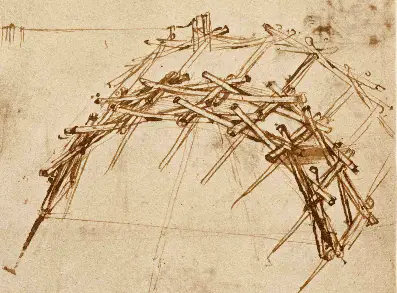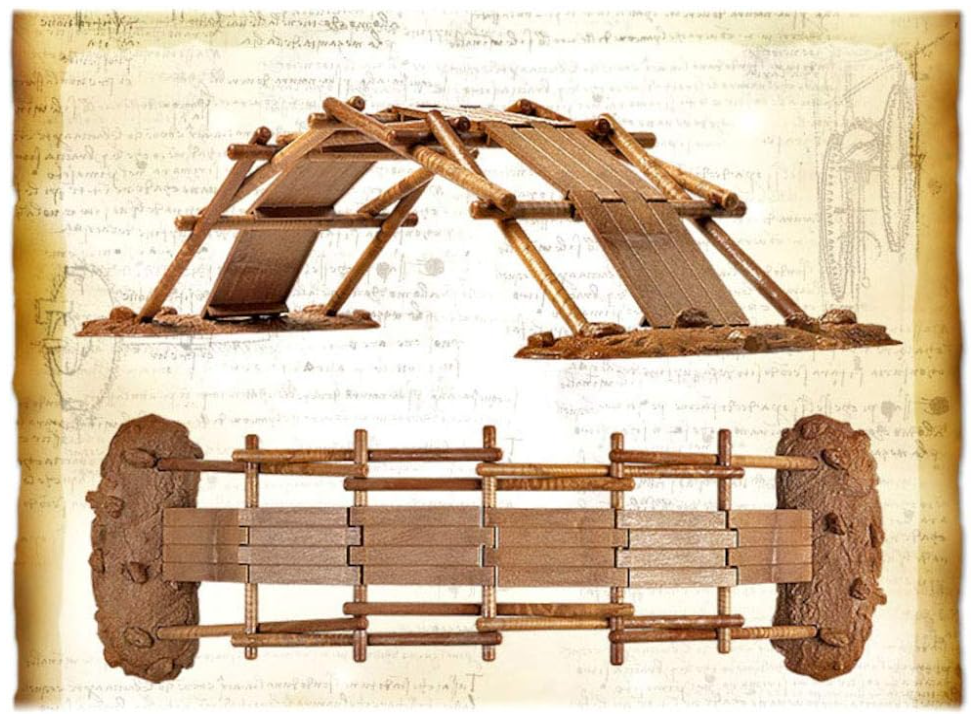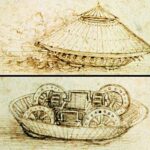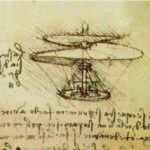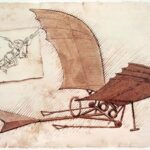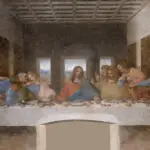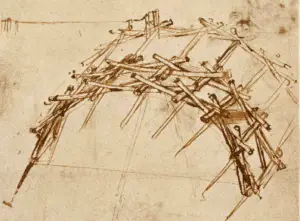
Da Vinci bridge
Leonardo self supporting bridge is one of the most famous inventions in history. It was, after all, the first-ever self supporting bridge.
DaVinci Bridge was designed while he was under the patronage of Cesare Borgia. Borgia employed Leonardo as his military engineer and gave him unlimited passes to inspect all ongoing constructions, in turn, Leonardo would design and build magnificent machines of war.
One such machine was Leonardo da Vinci bridge. Its simplicity and genius cannot be underestimated, and It was also a major step forward in the development of technology: one that allowed people to travel more quickly and safely across rivers than ever before.
How to build a da Vinci popsicle stick bridge
To build the bridge, Leonardo used a method that had never been used before: he laid out his design and then used ropes attached to pulleys to raise each stone block (or log) into place at once. This process required careful coordination with other workers and experts who helped him test each block’s stability before moving on to assemble the rest of the materials needed to build the bridge.
You can build a da Vinci bridge by yourself using popsicle sticks, called da Vinci popsicle stick bridge. But you need patience and the following materials:
- Da Vici bridge instructions
- Jumbo popsicle sticks
- Desk or table
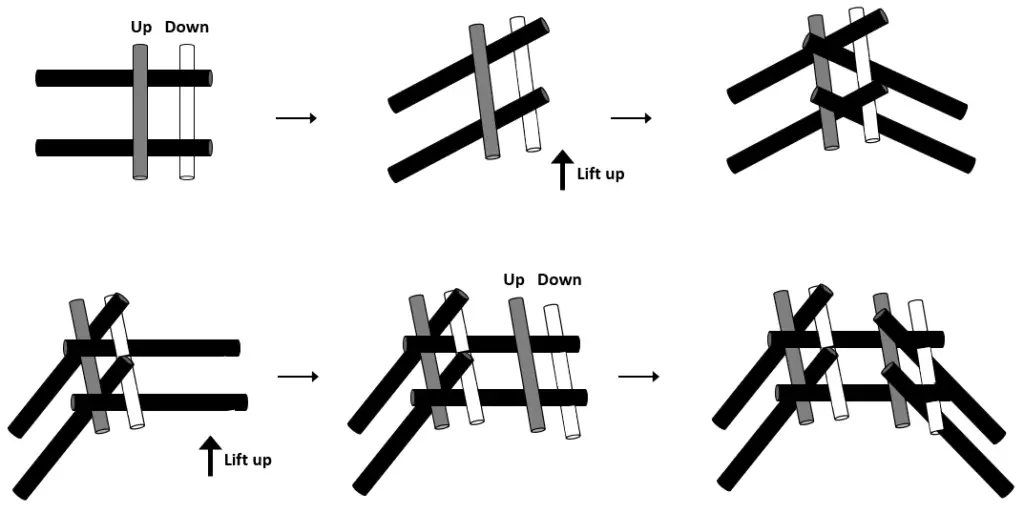
Da Vinci bridge made of popsicle sticks
Da Vinci bridge instructions for above scheme
- Arrange four popsicle sticks (upper left image), gray is up and white is down to the two black sticks
- Lift up the bridge (upper middle image)
- Put two black popsicle sticks from the right to weave the bridge (upper right image)
- Lift up again the bridge (lower left image)
- Arrange two popsicle sticks, gray is up and white is down (lower middle image)
- Put two black popsicle sticks from the right to weave the bridge (lower right image), the bridge can stand by itself from this stage (self supporting bridge)
- Repeat the process (lower middle and right image) according to the length of the bridge
Leonardo himself called it “Bridge of Safety,” and da Vinci bridge was just one of the ingenious bridges he designed throughout his life.
He also invented several other bridges, including a revolving bridge that, according to Leonardo da Vinci, “could be quickly packed and transported to enable fleeing armies to cross waters,” “cross streams or moats, put the bridge on the other side for easy passage of soldiers” and “fitted with a system of ropes and pulleys for quick deployment and easy transport”.
All useful tools for those who once aspired to military supremacy in Italy, But more useful for 21st-century renaissance boys and girls.
Why was the self supporting bridge needed?
It requires no specific skills to manufacture the parts, apart from a few men that are handy with an axe, da Vinci bridge can also be carried by a handful of men into any battlefield.
It requires no nails or ropes to hold it together and the bridge is self supporting and would be capable of holding a substantial amount of weight.
Leonardo da Vinci self supporting bridge was a remarkable feat of engineering. Though it was never completed, the design was sound and would have been a functional bridge.
Da Vinci design was ahead of its time and demonstrated his genius as an engineer.
How much weight can a da Vinci bridge hold?
A da Vinci bridge’s weight capacity depends on diverse factors like size, materials used, and construction techniques. Generally, a well-constructed bridge made from sturdy materials can support several hundred pounds or more.
However, Leonardo da Vinci bridges are not designed for heavy loads or long-term use. They should be used cautiously, considering factors like material condition, construction quality, and stress placed on the bridge.
- Model of the arch bridge designed by Leonardo da Vinci
- Self-supporting arch concept to distribute weight through the full curve of the arch
- No battery, paint, or glue required
11 facts about da Vici bridge
1. What inspired Leonardo da Vinci to design a bridge spanning the Golden Horn in Istanbul?
One of Leonardo da Vinci’s most famous architectural designs is a bridge spanning the Golden Horn in Istanbul, Turkey.
The Golden Horn played a significant role in the Ottoman Empire, and in the late 15th century, Sultan Bayezid II asked Leonardo da Vinci to design a bridge spanning the harbor.
Inspired by the beauty and importance of the Golden Horn, Leonardo da Vinci envisioned a bridge that was both functional and aesthetically pleasing, sturdy and graceful, with a simple and elegant design.
Despite its simplicity, the design was highly innovative, using a series of arches and buttresses to support the bridge, which would have made it one of the most stable bridges of its era.

Golden Horn bridge (Haliç Bridge), Istanbul
Unfortunately, the design was never built, but modern engineering and technology have made it possible to construct Leonardo da Vinci’s bridge design today, allowing us to appreciate its genius.
The Golden Horn bridge design (Leonardo da Vinci’s self supporting bridge design) remains an inspiration to architects and engineers around the world, setting a high standard for bridge design that continues to influence the field.
2. What is special about the Da Vinci bridge?
The Da Vinci Bridge is known for its innovative and unconventional design. Unlike traditional bridges, which rely on solid supports and multiple structural elements, this bridge is a self supporting arch made entirely from interlocking wooden planks.
Its simplicity and elegance make it a remarkable feat of engineering and architectural design.
3. How does the Da Vinci bridge work?
The bridge’s design is based on the principle of compression and tension forces. The self supporting arch distributes the weight of the bridge evenly, utilizing the inherent strength of the structure itself.
By precisely arranging the planks, the forces are balanced, allowing the bridge to stand without any external supports.
4. Did Da Vinci build a bridge?
Although Leonardo da Vinci is renowned for his drawings and sketches of the bridge, there is no historical evidence that he actually constructed it himself.
However, his detailed drawings and concepts demonstrate his deep understanding of engineering and his ability to envision groundbreaking structures.
5. Where is the Da Vinci bridge located?
One of the surviving replicas of the da Vinci bridge can be found in the town of Ås, Norway.
The bridge, based on Leonardo’s original design, was built in 2000 and serves as a testament to the bridge’s lasting legacy.
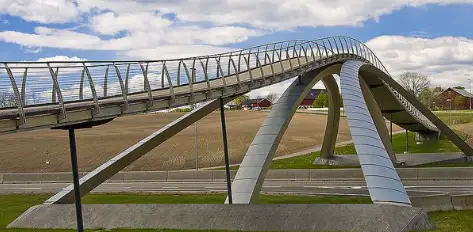
Da Vinci bridge, the town Ås, Norway
6. Why is the Da Vinci bridge so strong?
The strength of the da Vinci bridge lies in its unique geometric design. The interlocking structure distributes the weight evenly, enabling the bridge to withstand heavy loads.
The arch shape and the compression forces along the curved structure ensure its stability and resilience.
7. What is the most interesting thing about Leonardo da Vinci?
One of the most fascinating aspects of Leonardo da Vinci is his ability to bridge the gap between art and science. He was not only a masterful painter but also a prolific inventor, engineer, and anatomist.
His insatiable curiosity and passion for knowledge allowed him to make groundbreaking contributions in various fields, leaving an indelible mark on history as supported by his famous quotes.
8. How did Leonardo da Vinci’s bridge design influence modern bridge engineering?
Leonardo da Vinci’s bridge design for the Golden Horn in Istanbul, Turkey, has had a lasting impact on modern bridge engineering. Despite being created over 500 years ago, his design remains relevant and inspiring to engineers today.
Leonardo da Vinci’s innovative use of arches and buttresses to support the bridge was ahead of its time and helped set a standard for bridge design that continues to influence the field.
The principles of stability and simplicity that Leonardo da Vinci used in his bridge design can be seen in modern bridge construction around the world.
Today’s engineers have been able to build upon Leonardo da Vinci’s ideas and incorporate new materials and technologies to create stronger, more durable bridges.
9. What challenges did Leonardo da Vinci face when creating his bridge design for the Golden Horn?
Leonardo da Vinci faced a number of challenges when creating his bridge design for the Golden Horn in Istanbul, Turkey. One of the main challenges was the need to design a bridge that would be both functional and aesthetically pleasing.
The Golden Horn was a critical waterway in the Ottoman Empire and the bridge had to be able to accommodate both pedestrian and horse-drawn traffic, while also being an attractive landmark.
Another challenge was the limited technology and materials available at the time. Unlike modern engineers who have access to advanced technologies, such as computer-aided design (CAD) and advanced materials like steel and concrete, Leonardo da Vinci had to rely on his knowledge and intuition to create a design that would be both stable and durable.
10. How has Leonardo da Vinci’s bridge design been preserved and celebrated over time?
Leonardo da Vinci’s bridge design for the Golden Horn in Istanbul, Turkey, has been preserved and celebrated over time in a number of ways. Despite the fact that the design was never actually built, it remains one of Leonardo da Vinci’s most famous and revered works.
His plans were rediscovered and studied in the centuries following his death, and today they are widely considered to be some of the most important architectural plans in history.
The legacy of Leonardo da Vinci’s bridge design has been preserved through books, exhibitions, and digital archives. Many books and exhibitions have been dedicated to showcasing the design and exploring its significance in the field of engineering and architecture.
In recent years, digital archives have made it possible for people around the world to easily access and study Leonardo da Vinci’s bridge design, allowing them to appreciate the genius of his work and understand its impact on the field.
Additionally, there have been efforts to build full-scale models and replicas of the design, which help to demonstrate its functionality and highlight its innovative features.
Overall, Leonardo da Vinci’s bridge design for the Golden Horn remains an important piece of history and continues to inspire architects and engineers around the world.
11. Which technological advancements enabled the construction of Leonardo da Vinci’s bridge design nowadays?
Advances in technology have made it possible to construct Leonardo da Vinci’s bridge design for the Golden Horn in Istanbul, Turkey, today. Modern engineering techniques and materials have greatly expanded the capabilities of bridge construction, allowing engineers to bring Leonardo da Vinci’s design to life in a way that was not possible in the past.
New materials, such as advanced composite materials and high-strength steel, provide increased durability and stability, while computer-aided design and simulations allow engineers to test and optimize the design for optimal performance.
In addition, modern construction techniques have made it easier to build large, complex structures like bridges. Advances in crane technology, for example, have allowed engineers to build bridges that are both taller and longer than ever before. The use of prefabricated components and modular construction methods have also made it possible to build bridges faster and with less waste.
Overall, these advancements in technology have made it possible for engineers to construct Leonardo da Vinci’s bridge design for the Golden Horn with greater precision and efficiency, ensuring its stability and longevity for generations to come.
